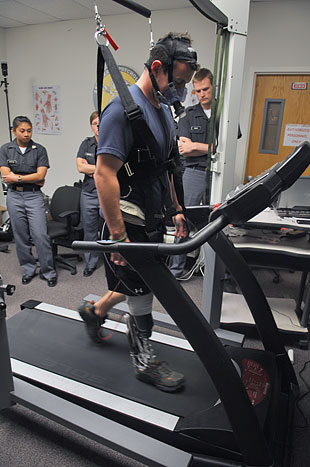West Point Cadets Achieve Motorized Running

West Point cadets have designed, built and tested the world's first lower-leg prosthesis to achieve motorized running. On April 23, filmed by the Discovery Channel, a Special Operations soldier who lost his lower leg in combat used the West Point-SpringActive Bionic Foot to run on a treadmill at 8 mph, the fastest any powered device has ever powered someone.
This computer controlled, motor-powered prosthesis generates the same push-off power and has the same joint motion as a natural foot and ankle. Current passive prosthetics have no ankle joint and rely on a spring, and thus cannot create the totally natural gait replicated by the bionic foot.
The WPBF is the only such effort focused completely on the needs of the wounded warrior.
It is funded by the U.S. Army Medical Research and Materiel Command's Telemedicine and Advanced Technology Research Center. The WPBF project is a continuing success story that is not atypical within TATRC's Advanced Prosthetics and Human Performance research portfolio, directed by Troy Turner. Notes Turner, "The way the WPBF is being developed?by undergraduate students?is perhaps as unique as the demands an active duty deployed warfighter would place on the foot."
The idea underlying the WPBF was first proposed to TATRC in 2006. Its genesis was with Dr. Tom Sugar at Arizona State University as the Spring Ankle with Regenerative Kinetics, or "SPARKy," robotic ankle. Ph.D. candidate MAJ Joe Hitt was collaborating with Sugar on the project. Hitt became LTC Hitt, Ph.D., and moved to New York to teach at the U.S. Military Academy at West Point. It was there that the idea of evolving the SPARKy ankle into a prosthetic foot uniquely designed for the demands of the deployed active duty military took shape.
Eight West Point cadets each year in the academy's Civil and Mechanical Engineering, Electrical and Computer Science, and Behavioral Science and Leadership departments have worked on the foot with Hitt since 2008. Cadets have gained much from this opportunity. One former team member has gone on to Yale Medical School and one is now a Rhodes Scholar.
This year will be the second summer that TATRC has hosted a West Point cadet in an internship. Interns learn about the research TATRC funds and manages, and spend time at Walter Reed Army Medical Center learning firsthand about the challenges facing wounded service members. They put this experience to work helping engineer the next phase of the WPBF.
Hitt says, "Others are doing great work out there with motor-powered prosthetics for better walking?but they're building a sedan for the mass market, and we're here to build a Humvee."
TATRC has supported the project since 2006 through the Army Medical Department's Advanced Medical Technology Initiative. The WPBF is also supported by the Army Research Lab, Walter Reed and Brooke Army Medical Center.
Says Lt. Col. Rachel Evans, research director for the Center for the Intrepid at BAMC, "When I talk to the severely wounded service members in rehabilitation here, the one thing they all want to do is to be able to run again. It's such an integral part of military culture. Being able to run with the bionic foot will make a wounded warrior feel like a real warfighter again."
This fall's team of cadets, led by West Point faculty member Maj. J.J. Johnson, will work on phase three of the device, which will enable running on any terrain. The ultimate goal is to develop a robust walk-run, all terrain, all weather, silent device that requires one battery charge per day.
Says Hitt, "By April 2011, we plan to prove the device will support a soldier taking the Army Physical Fitness Test. No one else in the world is doing this!"
The Discovery Channel filmed the April test as part of "Kamen Code," Segway inventor Dean Kamen's documentary series. The "Age of Bionics" episode is set to air this winter.
Hitt says the device could be Soldier-ready by 2012.
For more on this and other projects in TATRC's Advanced Prosthetics and Human Performance research portfolio, contact Portfolio manager Troy Turner at troy.turner@tatrc.org.














